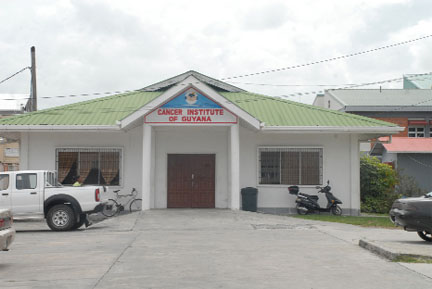
In Guyana more than 100 women were diagnosed with cervical cancer in 2007, a worryingly high number when account is taken of the fact that thousands of women in Guyana have never undergone screening tests for the disease. Dr. Vilma Perez, a Cuban-born medical practitioner currently serving in Guyana, says that her biggest concern has to do with what remains a low level of testing among Guyanese women despite the availability of testing facilities here. Dr. Perez, who, up until recently, served as Associate Consultant with the Guyana Cancer Institute and who is now in private practice at the St. Joseph’s Mercy Hospital says that on the whole women in Guyana need to be more mindful of health considerations. She says that while cervical cancer is a slow-growing cancer that is easily prevented through regular screening and treatment of pre-cancerous lesions, far too many women ignore the pre-testing option and seek medical advice and treatment only when they begin to develop signs of illness. In many cases, Indications of physical illness or signs of discomfort often suggest that the cancer is at an advanced stage. “In its early stages, cancers or pre-cancers have no signs or symptoms. The symptoms do not start until the cancer has spread and that is why it is important to have regular tests,” she says.

Research readily available on the internet indicates that, indeed, early cervical cancer often has no signs or symptoms. Symptoms often do not appear until the cancer is further along and has spread to other areas of the body. Symptoms of cervical cancer or pre-cancer may manifest themselves in:
1. Abnormal vaginal bleeding including bleeding after sex, bleeding after menopause, bleeding and spotting between periods and having periods that are longer and heavier than usual.
2. Unusual vaginal discharge.
3. Pain during sex.
While these symptoms are not necessarily indications of cervical cancer the appropriate response to them is to check with a doctor.
The cervix is the lower part of the uterus, the main body which provides a home for unborn babies. The part of the cervix closest to the body of the uterus is called the endocervix while the part of the uterus next to the vagina is called the exocervix. The two main types of cells covering the cervix are squamous cells, on the exocervix and glandular cells on the endocervix. The transformation zone, the area where these two types of cells meet, is commonly the area in which most cervical cancers start.
About Cervical Cancer
Cervical Cancer is caused by persistent infection with high-risk types of human papilloma virus (HPV), a common sexually transmitted infection which three out of four adults will contract some time in their lives. Most of these infections go away on their own without treatment. Those that persist can lead to cervical cancer. Medical research suggests that cervical cancer tends to occur in mid-life, primarily among women below 50 and rarely among women below 20. Many women, particularly those in developing countries where there is less access to health education, are unaware that they continue to be at risk as they grow older.
The Risk Factors
Several factors increase women’s chances of contracting cervical cancer. These include:
● Infection by the human papilloma virus (HPV) – a group of more than 100 related viruses that can infect cells on the surface of the skin, genitals, anus, mouth and throat. HPV can be spread during sex vaginal, anal and oral intercourse. Expert medical opinion holds to the view that women must be infected with HPV before they can develop cervical cancer. Condoms are believed to provide some limited protection against HPV.
● Smoking – Women who smoke are more likely to develop cervical cancer since smoking exposes the body to many cancer-causing chemicals.
● HIV – The virus damages the body’s immune system and places women at higher risk of HPV infections.
● Diet – Women with diets low in fruit and vegetables may be at increased risk for cervical cancer.
● Poverty – Many women with low incomes do not have ready access to adequate health care services including Pap tests.
Research also suggests that cervical cancer may run in families with women being 2 to 3 times more likely to fall victim to the disease if a mother or sister had it.
Human Papilloma Virus (HPV) is the world’s most common sexually transmitted viral infection of the reproductive tract, infecting an estimated 660 million people per year. It is also estimated to cause almost all cases of cervical cancer, 90% of anal cancers and 40% of cancers of the external genitalia. HPV also causes cancer of the oral cavity and the oropharynx. Of the many HPV genotypes, types 16, 18 and more than 10 other types are causal for cervical cancer. The most common high-risk genotypes, 16 and 18, account for about 70% of cervical cancer cases worldwide.
Cervical Cancer: The Guyana Story
Statistics on cervical cancer among women in Guyana acquired from the Cancer Research Institute of Guyana indicate generally upward trend in the incidence of the cancer between 2000 and 2007. Over that seven-year period the number of reported cases of cervical cancer more than doubled, increasing from 49 in 2000 to 106 in 2007. The highest number of reported cases of cervical cancer in any year during that period was 113 in 2005. During the same period a total of 306 women succumbed to the disease with 2005 witnessing the highest number of deaths, 49. Significantly, though perhaps not surprisingly, Region Four recorded the highest percentage of reported cases of cervical cancer (62 per cent) while Regions 1 and 8 recorded a mere two per cent of reported cases. These figures underscore the point made by Perez about the greater tendency among women in rural and hinterland areas to neglect to undergo precautionary tests.
Part of the focus of the Cancer Institute of Guyana is on raising public awareness of the services that it providers and creating a greater sense of awareness among women of the need to take precautions. Dr. Perez says that it is important that women in Guyana women in Guyana grow used to the following medical regimen:
● Women aged over 21 should obtain a Pap test which detects abnormal cells that can lead to cervical cancer.
●. Women aged OVER 30 should obtain both the Pap test and the HPV test as a routine part of cervical cancer screening. The HPV test detects the virus that causes cancer and serves to identify women who may be at higher risk and may be in need of closer monitoring.
What tests are accessible in Guyana for Early Detention of Cervical Cancer?
VIA …Visual Inspecting with the aid of acetic acid to help detect pre-cancerous lesions is a simple, low cost testing approach for woman in developing countries.
Pap Smear …is a procedure in which cells are scraped from the cervix for examination under a microscope. Pap smears are used to detect cancer and changes that can lead to cancer.
Both tests can be done by family doctors and by hospitals and health clinics in various parts of the country.





